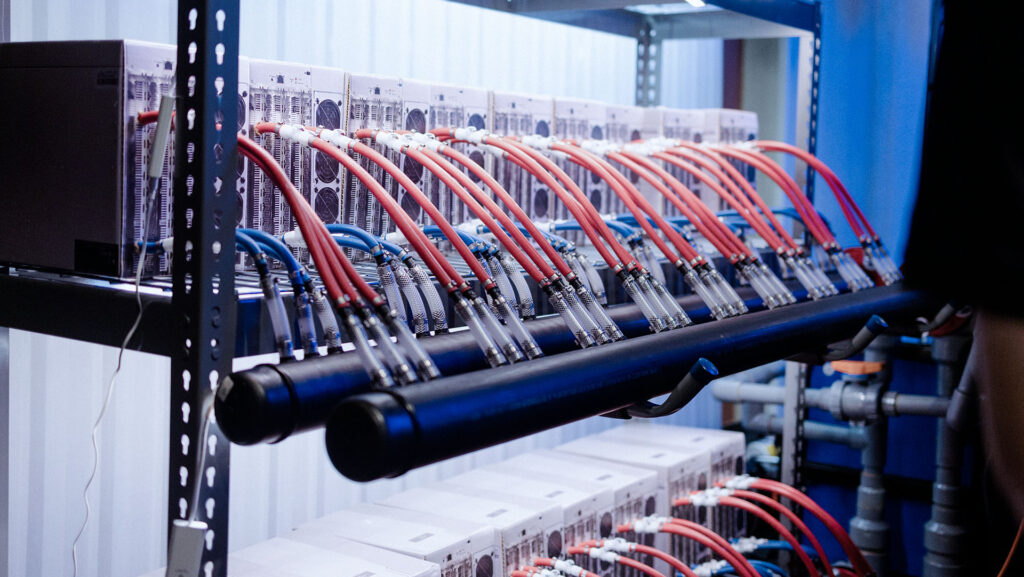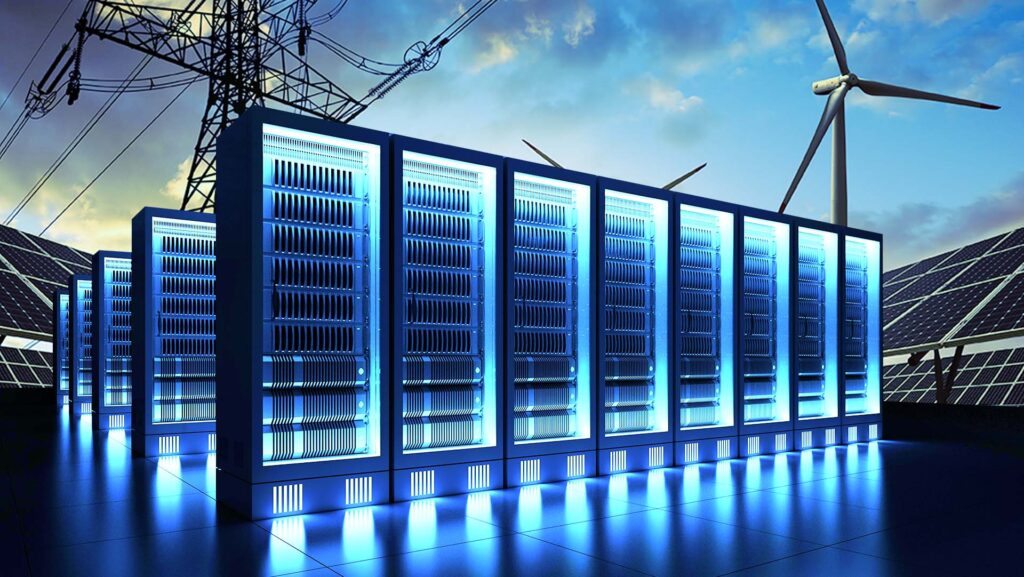As our reliance on digital tools increases, so does the need for more data centers.
A data centre is a complex operation that stores and shares information on a network of servers. These centres use a lot of energy. In Canada, data centres consume about one percent of the total electricity used each year. In the US, these spaces account for about two percent of the total energy consumed annually. The International Energy Agency estimates that data centres will be responsible for one-fifth of worldwide energy consumption by 2025.
As additional data centres are created, finding ways to become more energy efficient is crucial.
Data efficiency is a popular metric used by cloud storage companies to determine the environmental impact of large servers on global warming. Finding out Power Usage Efficiency, or PUE can help businesses get a sense of how they’re doing. To calculate PUE, divide the total amount of energy entering the data centre by the power being used to run it. The global average PUE is around 1.59, with data centres in North America sitting around 1.53. The ideal PUE ratio is 1.0, indicating that all the power is being used effectively. And that is possible!

What consumes the most energy in a data centre?
In an effort to keep data secure, there are many pieces of infrastructure in a data centre.
The size of a data centre can vary. You may have a small 100-square-foot room, or a 1,000,000-square-foot campus (like Google or Microsoft). Regardless of size, a typical data centre is energy-intensive. It is filled with servers, firewalls, routers, and storage systems that work together. They store, manage, and disseminate important information and support various business processes like email, video streaming, artificial intelligence, and machine learning.
Experts say the total worldwide annual energy use in data centres is between 196 to 400 terawatt-hours (TWh). When information needs to be safeguarded 24/7, it should be no surprise that a lot of energy is used. The flow of energy can never, ever stop! Power outages, while rare, are incredibly damaging. Most data centres also have a backup source of power, in case of outages.
Servers consume most of the energy in a data centre. They take up a lot of space, do all the work – storing, managing and processing information – and are often packed together, giving off more heat. As a result, sophisticated cooling methods are needed. This often also demands a lot of energy. A data center’s hardware and cooling systems consume as much as 86% of the total power used.
What is being done to minimize the environmental impact of data centres?
Multiple energy efficiency methods can be implemented to reduce the carbon footprint of data centres.
We recommend beginning with an assessment of the current state of the data centre – looking at energy usage across all of the equipment to see if one unit or area stands out as being inefficient. Replacing or upgrading some of your technology is a good first step to reducing the carbon footprint. You may discover you have server inefficiencies or “zombie servers” running for no reason.
Using immersion cooling instead of liquid cooling can boost efficiency as well. Immersion cooling is the process of submerging hardware into a non-conductive coolant to remove heat, instead of delivering that liquid via tubes. Pumps are used to circulate the liquid, reducing the temperature of the hardware. After the equipment has cooled, the system pumps the cool liquid back into the immersion tanks. This can be done in a single-phase or two-phase process. With an immersion cooling solution like the Intelliflex™ system, PUE in a data centre can drop to as low as 1.02, almost a perfect ratio. Immersion cooling has a far bigger power load capability than other cooling methods, which means overall operating costs can drop.
In addition, using renewable energy, like wind energy panels, hydroelectric plants, or solar panels, is becoming a common approach. For example, a 2019 survey predicted that 21% of data centers will rely on solar power by 2025.

Taking advantage of an eco-friendly design of the building itself can also help, like installing energy-efficient HVAC systems, implementing temperature controls, or arranging the equipment in a specific way. For example, many data centres have implemented an energy-smart layout, with hot and cold aisles. This involves organizing server racks in groups, so the fronts of servers (with cold air intakes) face each other, and the backs of servers (with hot air output) face each other. Using a hot and cold configuration prevents the warm air from mixing with the cool air, which means there is less overall cooling that needs to be done in the space. This can result in cooling savings of between 10 and 35 percent.
Certifications like LEED and Energy Star have established guidelines to determine if a building’s design and operation reduce carbon emissions and waste. They assess site development, energy efficiency, the materials used, and more. It is a goal for many businesses to achieve these designations, and a great framework to follow when trying to minimize environmental framework.
How can we make data centres more sustainable?
They have become much more sustainable in recent years, but there is a lot more work to be done to lessen the environmental impact of data centres. Not only does prioritizing sustainability in data centres lead to a happier, healthier planet, but it can also bring financial savings, improve system performance, and prevent data loss.
There are a few different approaches to take when making data centers more efficient. Updating cable management is one step to consider. Unfortunately, this is often overlooked. It is a big job, but when cabling is stored incorrectly, it can block airflow, leading to an even warmer space and bigger reliance on cooling systems. Energy Star recommends a cable mining program, or a process to continuously remove unused cables, as a way to stay on top of cable management.
Old, outdated technology eats up power. Replacing servers or other pieces of aging hardware can result in less power consumption. For example, some data centres may consider using low-power servers, which consume less energy than traditional tech. Some servers also have the option to switch to eco-mode. Also, check to make sure equipment that is no longer being used is properly turned off.

Creating policies outlining how to repurpose or recycle old hardware can help you avoid e-waste issues for your data center. In addition, partnering with a certified recycling agency can help with the proper disposal of old equipment. Google has adapted this circular economy model with its data centres, finding ways to reuse and recycle equipment. Regular evaluations are completed to determine inventory; those pieces are either repaired, wiped clean, recycled, or sold.
Adopting liquid immersion cooling is another way to enable energy sustainability in data centres, and at a much larger scale. With the Intelliflex™ system, you can achieve up to 95% efficient use of power, as it is built for high-performance systems. However, there are significant upfront costs with a liquid immersion cooling solution, and the design of each system is quite complex, so that is something to consider.
While they may be expensive, liquid immersion cooling solutions are easy to maintain, increase the lifespan of hardware, and most importantly, greatly reduce energy consumption, which means lower operating costs and more profits. Liquid immersion cooling solutions are the future of advanced data centres.
FAQs on the environmental impact of data centres:
Do data centers emit radiation?
All technology, including your smartphone and computer, emits very little electromagnetic radiation. The amount of radiation emitted from an average data centre is comparable to that of any office building.
How does cloud storage affect the environment?
A large amount of electricity is needed to power cloud servers. While cloud computing is more efficient than the alternatives, there is still an environmental impact due to 24/7 energy consumption.
What is the carbon footprint of data centers?
As our dependence on digital tools and technology increases, so does the associated energy consumption. It is estimated that data centers consume about 3% of the energy consumed on Earth.
Do data centers contribute to global warming?
Data centres account for approximately 2% of worldwide greenhouse gas emissions, which is in line with the aviation industry. However, some experts predict that could grow to 8% by 2030.
What is the biggest culprit in digital usage carbon emissions?
Streaming media, like watching a show on Netflix or Amazon Prime, is the biggest contributor to our online carbon footprint. However, watching shows at a lower video quality, or watching physical media like DVDs or Blu-Rays, is much more friendly to the environment.
